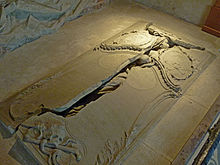Tomb of Maria Magdalena Langhans

The tomb of Maria Magdalena Langhans is a work by the Rococo sculptor Johann August Nahl in the Hindelbank church .
history
Johann August Nahl the Elder Ä. stayed in Hindelbank in 1751 to create a tomb for Hieronymus von Erlach , and lived with Pastor Georg Langhans and his wife Maria Magdalena Wäber during this time . In the Holy Week of 1751, the pastor's wife died at the age of 28 giving birth to her first child, a boy who also died soon after. Thereupon the shocked guest created a tomb for mother and child on his own initiative, in which he addressed the resurrection.
Until 1911, the tomb was embedded in a depression in the choir of the church and was protected by a wooden cover that the Sigrist lifted for viewing. The visitors to Frau Langhans' tomb included Goethe , Arthur Schopenhauer , Karl Graf von Zinzendorf and Albert Anker . In the 18th century, numerous copies and pictures of the tomb were made, which were sold as souvenirs. In some cases, for example in an etching by Christian von Mechel or a replica in biscuit porcelain from Niderviller , the inscriptions were not reproduced.
In 1911, a large part of the church was destroyed by fire, and Nahl's work survived the disaster because the wooden cover protected it from the falling debris.
description
The sculpture is carved from a single stone and depicts a grave breaking open. In a crack in the bursting grave slab, Mary Magdalena Langhans and her son can be seen looking upwards; the child also extends his arms towards the sky. The son is naked, the mother partially covered with a cloth. Death symbols and the coat of arms of the Langhans family can be seen on the broken cover of the crypt. There are also various inscriptions on it; the one in the center comes from Albrecht von Haller and reads: “Listen! The trumpet calls out, it resounds through the grave / Wake up, my painful child, take off your cover / Hurry to your Savior, before him death and time flees / And all suffering disappears in eternal salvation. ”Furthermore, it can be read on the grave cover : "Lord, here I am and the child that you gave me!"
classification
The tomb, created during the transition from the High Baroque to the Enlightenment , shows a “personal resurrection”, in which the dead retain their individuality in eternity. York-Gothart Mix described the work as a "signal work of the epochal change towards sensitivity and pre-romanticism".
In 1997, the artist Günter Lang also created a work of art showing a grave breaking open. But here the body changed by death remains and only spirit and soul celebrate resurrection.
Web links
- Description on the website of the Reformed parish Hindelbank
Individual evidence
- ^ August Laube: Helvetica. Drawings and graphics. Zurich 2009, pp. 82–84.
- ↑ Archive link ( Memento of the original from October 24, 2011 in the Internet Archive ) Info: The archive link was inserted automatically and has not yet been checked. Please check the original and archive link according to the instructions and then remove this notice.
- ^ York-Gothart Mix: German-Swiss cultural transfer in the 18th century. In: The Eighteenth Century. Journal of the German Society for Research in the Eighteenth Century. Wallstein 2002, ISBN 978-3-89244469-5 , p. 221.
- ↑ Hans-Kurt Boehlke: On the Central Institute and Museum for Sepulchral Culture: History of the Arbeitsgemeinschaft Friedhof und Denkmal e. V. Part Two 1977–1992. Kassel University Press, Kassel 2007, ISBN 978-3899583274 , p. 8.

